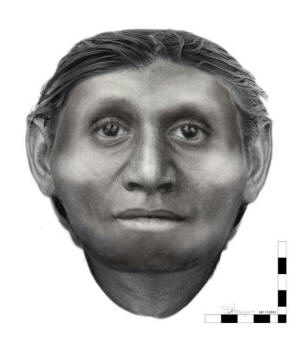|
New fossils may settle debate over
'Hobbit' people's ancestry
 Send a link to a friend
Send a link to a friend
 [June 09, 2016]
By Will Dunham [June 09, 2016]
By Will Dunham
WASHINGTON (Reuters) - Fossils unearthed
on the Indonesian island of Flores may resolve one of the most
intriguing mysteries in anthropology: the ancestry of the extraordinary
diminutive human species dubbed the "Hobbit."Scientists on Wednesday
described bone fragments and teeth about 700,000 years old retrieved
from an ancient river bed that appear to belong to the extinct Hobbit
species, previously known only from fossils and stone tools from a
Flores cave ranging from 190,000 to 50,000 years old.
The species, called Homo floresiensis, stood about 3-1/2 feet tall
(106 cm), possessing a small, chimpanzee-sized brain.
The new fossils "strongly suggest" the Hobbit evolved from
large-bodied, large-brained members of the extinct human species
Homo erectus living in Asia, said palaeoanthropologist Yousuke Kaifu
of the National Museum of Nature and Science in Tokyo.
Homo erectus, which first appeared in Africa roughly 1.9 million
years ago, is known from numerous fossils 1.5 million to 150,000
years old from Java, an Indonesian island west of Flores, and the
new Flores fossils bear similarities to those, said paleontologist
Gerrit van den Bergh of Australia's University of Wollongong.
The fossils included four adult and two baby teeth, a piece of
jawbone and a cranial fragment from two children and either one or
two adults who may have died in a volcanic eruption. They were dug
up during excavations in grasslands nearly 45 miles (70 km) east of
the cave where the first Hobbit bones were discovered in 2003.
 The jawbone's size suggested the individual was even a bit smaller
than the later cave remains.
Previously discovered stone tools suggest the Hobbit's big-bodied
ancestors reached Flores a million years ago, indicating the species
shrank during 300,000 years of evolution.
"It now appears that the Flores 'Hobbit' is indeed a dwarfed Homo
erectus," said archaeologist Adam Brumm of Australia's Griffith
University.
The research was published in the journal Nature.
Size reduction that occurs over many generations of larger mammal
species, such as elephants, that somehow reach a new island habitat
is called the "island rule," driven by limited food resources on
islands.
[to top of second column] |

This artist's illustration shows the head of the diminutive extinct
human species Homo floresiensis, better known as the 'Hobbit,' known
from fossils unearthed on the Indonesian island of Flores. Newly
discovered fossils indicate that these tiny people evolved from a
big-bodied extinct human species called Homo erectus that first
arose in Africa and later spread to Asia. Courtesy Susan
Hayes/Handout via REUTERS

Brumm said the 700,000-year-old fossils rule out claims by some
scientists that the Hobbit was a member of our species with a
medical condition causing small size. Homo sapiens first appeared in
Africa about 200,000 years ago.
Characteristics of the fossils also do not support the idea the
Hobbit evolved from even more ancient members of the human family
tree like Homo habilis or Australopithecus, the researchers said.
(Reporting by Will Dunham; Editing by Paul Simao)
[© 2016 Thomson Reuters. All rights
reserved.]
Copyright 2016 Reuters. All rights reserved. This material may not be published,
broadcast, rewritten or redistributed.

 |